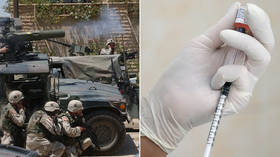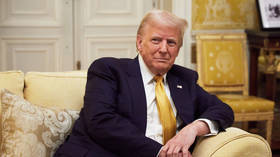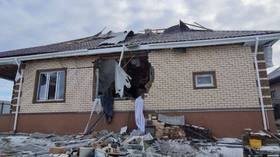Trump admin blames China for 2 months lost in coronavirus prep as experts warn flaws in US health system doom its readiness
While the Trump administration continues to blame China for “covering up” the coronavirus outbreak in December, government failures closer to home have left the US unprepared for the epidemic hitting its own shores, experts fear.
Blaming China’s failure to “use best practices” for two months in lost response time to the Covid-19 epidemic, US National Security Advisor Robert O’Brien lamented on Wednesday that “we could have dramatically curtailed what happened” – even as the country’s leading doctors and scientists have warned the president is running out of time to effectively respond to the outbreak.
Also on rt.com Draconian response to coronavirus may be worse for global economy than epidemic itselfO’Brien vaguely cited “lots of open source reporting from Chinese nationals” to back his point, struggling to shore up Washington’s efforts to lay the epidemic that has so far spread to half of US states, infecting over 1,000 Americans and killing 31, at China’s door. At least 10 states have declared emergencies as of Wednesday, and disease experts are throwing up their hands, urging the administration to take real-life events more seriously.
“What I find really concerning is we’ve really not set the agenda here for the American public I think in a realistic way,” public health expert Michael Osterholm told CNBC on Tuesday, comparing the government response to preparing for “the Washington DC blizzard” – an intense but brief snowstorm – when what’s really in store is “a coronavirus winter” where “we’re in the first week.”
The US has already failed to arrest the virus in the containment stage, meaning “there will be widespread transmission of this virus around the country,” Osterholm predicted, echoing the worried prognostications of other epidemiologists. Centers for Disease Control director Robert Redfield agreed that critical regions of the US are beyond the reach of containment, sliding into the “mitigation” stage, and blamed the botched rollout of test kits to local health workers.
If you’re a week late, it matters.
The availability of accurate tests for Covid-19 has become a major sore spot, with official reassurances colliding with uncooperative reality in full view of the public. Secretary of Health and Human Services Alex Azar insisted on Tuesday that “millions” of tests were available, even as the CDC urged healthcare providers to save tests for symptomatic patients already hospitalized and “medically fragile individuals.”
In at least one case, federal officials warned a Seattle lab against testing flu swab samples for coronavirus in January, before the epidemic was widely reported, losing critical response time – mirroring the “crime” the Trump administration has tried to pin on China.
And some have warned that the US’ inability to handle an outbreak is more dire than either side realizes. During a House Appropriations Committee hearing on Tuesday, a Republican congressman from Washington, the first Covid-19 hotspot to flare up in the US, demanded to know why his constituents were unable to get their test results while his fellow congressmen had no problem getting tested just days after coming into contact with an infected person at a DC political conference. A CDC representative admitted “there’s not enough equipment. There’s not enough people. There’s not enough internal capacity. There’s no surge capacity.” To conserve tests, the CDC has told healthcare providers to “use their judgment” and consider “epidemiologic factors” before using up a valuable resource.
Existing flaws in the US healthcare system have exacerbated the testing problem. The CDC has refused to set up standalone testing centers, placing COVID-19 screening out of the reach of the many Americans who don’t have primary-care physicians and rely on walk-in clinics and emergency rooms for their healthcare.
There need to be millions of tests disseminated across the U.S. at pop-up clinics for people w/ even the slightest concern about infection to go and get tested. Instead, our gov't wants ppl to go through arduous process of meeting w/ their doc 1st. https://t.co/ZLoVp5NoJf
— Chuck Ross (@ChuckRossDC) March 11, 2020
Just 8,500 Americans had been tested as of Monday, according to the CDC, and federal officials told reporters some 75,000 tests had been sent out to public health laboratories on top of one million sent to hospitals and other sites. The real-life infected numbers in the country are thus likely much higher than what is being reported.
Control measures have varied wildly across local governments and institutions and even within cities. Over 1,000 schools have closed nationwide, and cities and counties from Santa Clara, California to Westchester, New York have banned large gatherings. The National Institutes of Health’s Anthony Fauci called on others to follow suit during a congressional hearing on Wednesday, announcing “we would recommend that there not be large crowds. If that means not having any people in the audience when the NBA plays, so be it.” Asked if “the worst” was yet to come, Fauci answered unequivocally: “bottom line, it’s going to get worse.”
House Oversight Cmte. Chairwoman Maloney: "Is the worst yet to come?"Dr. Fauci: "Yes, it is." pic.twitter.com/MQQJlzWgad
— NBC News (@NBCNews) March 11, 2020
Even as new Covid-19 cases in China dwindle to near zero and cases in Italy, Germany, and other European countries surge, the US has not stepped up screenings of passengers from those countries at airports accordingly. Instead, the administration has continued to congratulate itself on “saving lives” by halting flights from China weeks ago.
Like this story? Share it with a friend!













